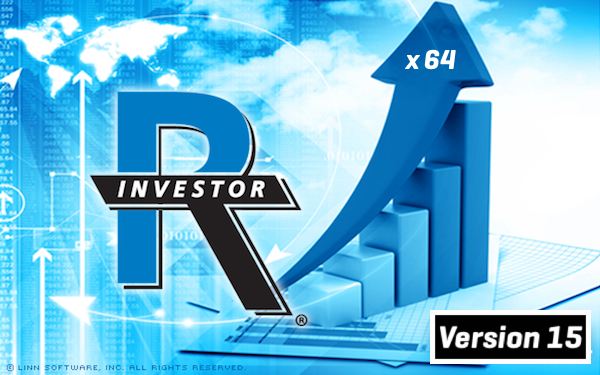13.6 Released September 3, 2019
13.7.10 Released December 10, 2020
NOTE: Investor/RT 13.7 is now available to users who wish to remain on the RT 13 database system. RT 13.7.x includes the same new features and improvements outlined in the article What's New in RT 14 with the exception that it continues to use the database system that has been used by Investor/RT since inception. For more information on the transition from RT 13 to RT 14 see the forum article Investor/RT Road Map.
-
About 13.6 (see Note above about 13.7 )
Investor/RT 13.6 is a maintenance release that incorporates all recent fixes, minor improvements and a few noteworthy enhancements listed below. Investor/RT 13.6 is the final release that utilizes the 32-bit database engine that has been incorporated into the software since inception. Linn Software will soon initiate beta testing of Version 14. This major new release incorporates a new database engine that eliminates the database file size limitations inherent in RT 13 and earlier. RT 14 will thus permit more tick data and one minute interval data to be retained per symbol and generally will permit more symbols to be tracked with those retention settings. To achieve a smooth migration from RT 13 to RT 14, it is essential that all users update to Version 13.6. This release includes a migration function accessible from the File > Functions menu. The Migrate Database Content function is run automatically periodically so that all setups will be available to RT 14 upon upgrade. Or you can run this function manual from the File menu just before moving forward onto RT 14. This function will create migration files in the admin directory that will be detected the first time RT 14 is run. The migration files will be used to setup the new database with all charts, historical data, and other user settings exactly as defined in RT 13. RT 14 will have the same features as RT 13.6 and will look and feel exactly the same. RT 14 will undergo a month or two of public beta testing before general release to all customers later this year. This transition to RT 14 under a 64-bit compatible database engine is an essential first step in moving the platform to a full 64-bit implementation.
By default, the migration files are created daily to ensure that all of your setups are ready for update to Investor/RT 14. This process also involves creating a restore point of your database. The process adds a few seconds to the startup process each day. You may turn off the migration process by going to File > Preferences > Configuration and setting AutoCreateRT14MigrationFiles to zero. Or you may also set the frequency by setting AutoCreateRT14MigrationFiles to some number of days. e.g. set AutoCreateRT14MigrationFiles to 5 and the migration process will only occur every 5 days.
-
Version 13.6 Miscellaneous Enhancements
- Chart Button Purpose "Execute Function" Button purpose Execution Function is now available. A button with this purpose can perform any function available in the File > Functions window. Setup the button with the name of the function, optionally followed by a colon and a parameter required by some functions.
- Chart Menu Buttons Custom Titles Chart Buttons that offer a menu of choices may now have custom titles and colors. The user-specified title appears with a down arrow at the right to denote that the button will bring up a menu instead of performing an immediate action (i.e. a push button). For example, right-click in any chart and choose Add Button.... A menu button will then appear in the chart setup with a custom title for selecting an instrument for the chart.
- Chart Buttons Custom Colors Chart push buttons have always enabled customization of the background color of the button. The button setup now permits the specification of a text color. This is useful when creating a button with a custom dark background. Use the text color setting to choose a lighter color that contrasts well with the background color. Further, chart push buttons with purpose Add/Remove Indicator or Show/Hide Indicator now offer two background colors; one is used when the subject indicator is active in the chart; the alternate background color is used when the subject indicator is not present or is hidden in the chart. This enables you to see at a glance whether pushing the button will add or remove, or show or hide the subject indicator.
- Indicator Popup Menu When right-clicking on a chart indicator, the ensuing popup menu now offers two new indicator drawing order choices: Bring to Front of Instrument and Send Behind Instrument.
- File > Functions > Migrate Database Content Use this migration function to export all of your symbols, historical data, quote pages, charts, indicator setups, presets, RTL objects and all other setups. Two migration files are produced and saved in the InvestorRT/admin directory. Upon upgrade to Investor/RT Version 14, these files will be used to automatically migrate all user data to a new database engine. See About 13.6 above for more details.
- File > Functions > Trading Position History This function creates a worksheet showing trading history for a user-specified period of trading. Periods include Today, Yesterday, This Week, Last Week, This Month, Last Month, This Year, All Years. The position history worksheet is a .CVS file than Investor/RT opens in Excel or the application you have setup to view .CSV text files. A variety of output formatting options are available for advanced uses. If interested, see the Configuration variable PositionHistoryCSVFormat.
- ChartTradingDOM Account Menu > Trading Results The function Trading Position History is integrated with the ChartTradingDOM. Click on the Account menu at the bottom of the trading DOM and choose the desired reporting period from the Trading Results menu.
- Chart Element Manager When using the Chart Element Manager (CEM) to review the content of a chart, you may now add one or more indicators to the chart by pressing the plus button at the top of the window. The CEM remains open after adding indicators in this fashion. Earlier versions required the CEM to be closed in order to add an indicator.
- Adding Indicators The Add Indicator dialog opens showing a panel at right for choosing an indicator. When the intent is to add an RTX Extension to the chart, check the box Choose an RTX Extension at the top of the panel. When checked, the Add Indicator display lists only RTX choices. In addition, there is a search feature in the panel. Point the mouse over the Enter search text entry box and begin typing to limit the displayed indicators to those with names containing the text you enter.
- Inside Body Merge and Inside Bar Merge - Layered Periodicities Two powerful new layered periodicities are available: Inside Body Merge and Inside Bar Merge. These periodicities can be applied on top of any other periodicity. The Inside Bar Merge Periodicity will merge any bar into the previous bar if the bar is inside the range of previous bar. In other words, as long as the bar does not break outside of the range of the previous bar, it will simply get consumed and merged into the previous bar (including volume at price data). The Inside Body Merge periodicity works similarly, but merges when the body is inside the body of the previous bar. Inside Body Merge work especially well when applied to periodicities such as 2x2 Renko where several consecutive bars often have matching bodies due to congestion. Inside Body Merge will merge that congestion into a single bar.
- Indicator Drawing Positioning When right-clicking on an indicator in a chart, two menu options have been added to the ensuing popup menu: Bring to Front of Instrument and Send Behind Instrument. These options complement the existing ones (Bring to Front and Send to Back). Bring to Front moves the indicator in front of all other elements in the chart. Send to Back sends the indicator behind all other elements in the chart. Bring to Front of Instrument moves the indicator just in front of the underlying Instrument (bars) while possibly leaving it behind the other indicators / elements that are in front of the instrument. Send Behind Instrument will position the indicator for drawing immediately behind Instrument (bars) while leaving it in front of any other elements that were already behind the Instrument. The four positioning choices expedite chart setup, positioning indicators where you wish in the element drawing order. You can reviewthe drawing order of elements in any chart pane by double-clicking inside the chart to open the Chart Element Manager. Element drawing order can be adjusted for any indicator using the element manager; the new menu choices faciliate such adjustments directly from the indicator's popup menu.
- MPH - Data of 2nd Highest The Multiple Price Highlighter (MPH) RTL token offers new data result options: Data of 2nd Highest and Data of 2nd Lowest. These are available only when using MPH within an RTL formula. Data of 2nd Highest will extract the data from the 2nd Highest price in the bar that was identified by MPH using the criteria at the top. Data of 2nd Lowest is similar, extracting the data of the 2nd lowest price that was identified by MPH.
- Fractals - Extend Only In Range The Fractals Indicator now features an option for extended naked High/Lows. A checkbox titled Extend Only If Within Range of X Ticks, when checked, limits the naked extensions to those in close proximity of current price. This can clean up the chart significantly while still showing the relevant extensions that are close to current price action.
- Profile Indicator - Storing VA / POC Values The Profile Indicator may now be setup to set a variety of combinations of VAH, VAL, POC, VAH2 and VAL2 values into a series of 1 to 5 V# or C# user variables.
- Zig Zag Labeling with Custom Indicator A new labeling option is available in the Zig Zag Indicator When CustInd,is checked, Zig Zag will identify the custom indicator present in the chart that has the identical Text Label as the Zig Zag Indicator itself. Note: the Text Labels (seen below the indicator preferences) must match precisely. Zig Zag will label each pivot with the value of that custom indicator at that pivot. This provides a great deal of flexibility to the already extensive list of Zig Zag pivot labeling choices.
- MPH Filter Options Two additional filtering options are supported by the Multiple Price Highlighter indicator: Price from Extreme and Percent from Extreme. These filters will narrow the highlighted price to those with the specified number of prices from the extremes (either high or low of bar), or within that Percent (of bar range) from the extreme. For example, 25 Percent from Extreme would limit the highlighted prices to those that are in the upper or lower quadrant of the bars range.



